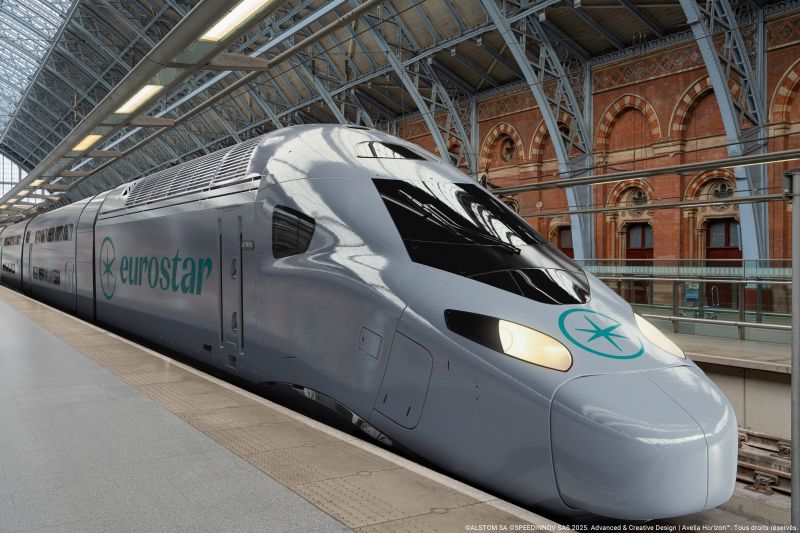Eurostar today announces a landmark €2 billion* investment in up to 50 new double-decker trains built by Alstom Group – the first ever to operate through the Channel Tunnel and on the UK network.
Eurostar has confirmed an order for 30 trains, with an option for a further 20, marking a significant step in Eurostar’s growth journey to 30 million annual passengers.
The new fleet, named Eurostar Celestia will be a bespoke design created from Alstom’s Avelia Horizon platform. The 200-metre trains will be interoperable across all five countries served today plus new destinations of Geneva and Frankfurt.
“Eurostar Celestia”, the Next Generation of Eurostar Trains
Eurostar Celestia will have a bespoke design to capture the unique, premium experience Eurostar customers expect. The name of the fleet, selected by members of the Eurostar team, is derived from the Latin word caelestis, meaning “heavenly”. It evokes the stars and the essence of travel, perfectly capturing the spirit of a company that links a constellation of cities across Europe.
Seat capacity will increase by 20% on each new train, subject to final design specifications. It is expected that each 200-metre set will have around 540 seats. If running in 400m formation (as through the channel tunnel today), there would be around 1,080 seats per service.
The first trains are due to join the fleet in January 2031, with commercial services launching in May 2031. Six new trains will be operational at that time, marking the beginning of a new era for Eurostar and its customers on board Eurostar Celestia.
Once delivered, the new trains will operate alongside Eurostar’s current fleet of 17 e320s, bringing the total fleet to 67 trains – a 30% uplift overall versus today.
Eurostar plans to maintain the entire fleet at the Temple Mills depot in London, which would be developed to accommodate the new trains at a cost of around €80m. The new fleet will create around 350 more highly skilled jobs at the depot, continuing its heritage as a centre of excellence for international high-speed rail. Today, over half of all Eurostar jobs are already UK-based, with 450 of those based at Temple Mills.
Sustainable and Accessible Travel for All
The new Eurostar Celestia all-electric fleet is designed with sustainability and accessibility at its core, supporting the company’s long-term environmental goals and offering an enhanced level of access and comfort for all passengers and team members working on board. The design process includes input from passenger and accessibility groups, as well as 100 Eurostar team members.
Gwendoline Cazenave, CEO, Eurostar said: “Placing this milestone order marks the concrete realisation of Eurostar’s ambitious growth strategy – to reach 30 million passengers by investing in a brand-new fleet. We’re particularly proud to bring double-decker trains to the UK for the very first time.
“Customers can expect a very special new train with Eurostar Celestia, which will offer exceptional comfort, a unique Eurostar experience and new surprises to be revealed. This is a golden age for international sustainable travel – and Eurostar is leading the race.”
Henri Poupart-Lafarge, Chief Executive Officer of Alstom, said: “By choosing Avelia Horizon to renew its fleet, Eurostar is confirming its desire to combine technological performance, energy efficiency and passenger comfort. This new-generation train, designed to meet the demands of international very high-speed traffic, embodies our vision of sustainable and competitive European mobility,”
About the new Celestia train
- Delivery of 50 trains (30 trains on firm order, 20 options) under the framework agreement between SNCF Voyageurs and Alstom, of which Eurostar is also a beneficiary.
- Production slots are guaranteed by the manufacturer for all 50 trains. This order will enable the creation of a bespoke offer for Eurostar customers.
- The most sustainable trains we’ve ever operated:
-
-
97% recyclable components, 25% made from recycled materials.
-
-
20–50% energy savings compared to current fleet.
-
-
Designed to withstand climate change impacts, ensuring long-term resilience.
-

